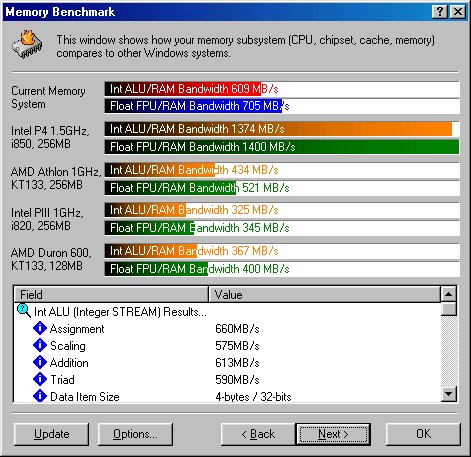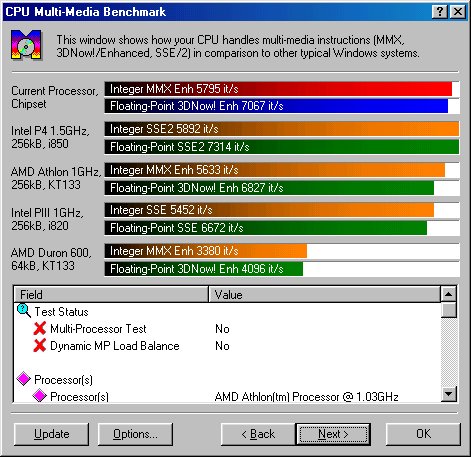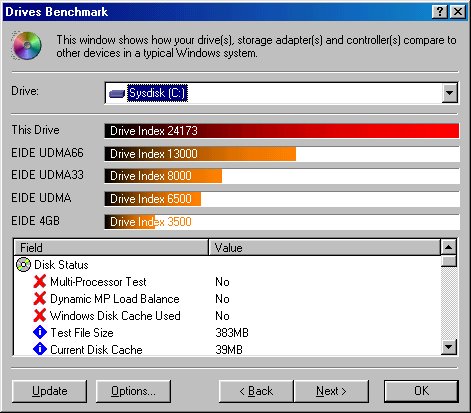Iwill KK266-R
Iwill KK266-R review.
Introduction
Following up the original KT133 chipset from Via was never going to be an easy task in the Socket A market as it has been from the outset about the only worthwhile chipset out there. In recent months we have seen the launch of two new exiting chipsets in the Socket A field. These are the New Via KT133A and the Ali Magik1 offerings. The main difference here is the inclusion of ‘proper’ 133/266fsb support in the KT133A and the fact that the Ali boards use new DDR memory. The Iwill KK266-R is a KT133A offering of the highest Quality.
First Impressions
When I found out I would be
reviewing this board my first thoughts were Iwill?
Who? I made a preconception
that the board would be rubbish and not be anywhere near as good as my Abit and
Asus boards, how wrong can you be…
Now its not often that I get
too excited when I open a parcel and pull free a motherboard box but this time
it looked a little different and was actually presented well.
The standard Iwill packaging is nothing short of amazing and protects the
board and kit very well. The first
thing noted on the layout of the board was the well thought out placing of the
ATX connecter at the extreme top edge of the board well out of the way.
The Manual was an easy read although their English translations are not
superb J.
Nice also to see included a very comprehensive guide to using the onboard
Raid controller, a feature that other manufacturers seem to overlook.
The Kit

I am not going to bore you by
putting all the specs of this fine motherboard in as these can be found in a
very comprehensive page at the Iwill site here.
Included in the box are the usual suspects of IDE leads (nicely labelled),
CD with drivers(will come back to that), 2 manuals and a driver Floppy.
The CD that comes with the Motherboard is bootable which is a nice touch.
It loads a funky Linux front end that then allows you to create driver
discs should you need the raid controller during Winnt/2k set-up, again a nice
touch. The board conforms to the
normal ATX pattern so fitting should not be a problem.
Here is the kit I used for the test
- Iwill KK266-R
- AMD Tbird 1G
- 256mb Crucial 133 Cl2
- Leadtek Geforce DDR
- Sblive 1024
- Asuscom ISDN TA
- Netgear FA310Tx NIC
- IBM 75GXP 30.7Gb
- Plexwriter 8x4x32
Fitting and set-up
Fitting was a breeze what more can I say. The only glitch being the full row of capacitors below the CPU socket that made heatsink fitting a bit testing on their patience, a small point I know. After referring to the excellent manual I configured the few jumpers on the board ready to power her up after connecting all the peripherals. One strange jumper that you will come across is the one to set the FSB manually. Here you can select 132 and below or 133 and above. There is a very good reason for this, which I will cover later.
After a triple check to see
if we were all together properly I fired her up ready to dive into the bios for
a snoop around. Nothing, nothing at
all. Hard drives spin up and power
lights on but nothing. A quick
power off and a short of the cmos later ad we were in the Bios.
The board uses and Award bios so it was kinda familiar in there and I
felt quite at ease configuring everything ready for Windows.
On thing that was missing were memory timings from your standard Award
bios. I could select the CAS level
(2 or 3) and set the memory +33 but
no more, I felt a bit annoyed at this as it is a useful ‘tweaking’ feature.
Hit F10 for the save and format my drive ready for windows.
Windows install went just
fine, no glitches at all. Upon
first boot in went the latest official 4in1’s from Via’s site along with the
Raid driver, DX8a, Detonator 6.50’s and the required drivers for the rest of
the hardware. A few reboots later and we were all done, or so I thought.
Unfortunately at this point my hair started falling out at an incredible rate. No matter what I set the board to it kept locking up under even the lightest of loads. Having read a few posts in forums around the globe this was a rare occurrence with the board so on I soldiered. After 4 different sticks of memory, 2 different Hard drives, 2 different video cards and a shed load of help from Jackie0 on the Hard forums and Xev we got it sorted. The board plain refused to work with my SoundBlaster 1024 live in it. No matter where we put it or what irq we gave it the machine would fall over all the time. So another format and install later with the onboard sound enabled it was looking good. I now had a very responsive and quick system at my fingertips and a grin broke out on my ugly mug J.
Bios tweaks and
Overclocking
There are currently no bios
updates available from Iwill but that will change soon I guess but the guys at www.turkoc.com
have sorted out a custom bios of their own.
You can find it here
for the non-raid board and here
for the Raid version. Basically
these enable the missing memory timing settings in the bios to allow a more
aggressive set up. Please remember
that these are unofficial bios’ and as such are not guaranteed in any way.
Those of you used to Abit’s
‘softmenu’ system will be right at home with this version.
The Iwill Smart Setting section in the bios allows you to change the
Voltage, Multiplier and FSB of the chip and motherboard (providing you Cpu is
unlocked). Remember the FSB jumper
I mentioned at the start? Well this
is where it comes into play. Basically
with it set to 132 and under the maximum FSB selectable is 132 and you also have
the ability to set the memory bus to +33 in the advanced chipset features.
This will give you a theoretical maximum of 165mhz.
Using the board in this mode I could only achieve 148mhz.
After resetting back to 100fsb and turning the +33 off I powered down and
moved the jumper to 133+ on the motherboard.
It is important to note that you must first turn the settings for these
to default in the bios before moving the jumper or you will not be able to boot.
Once this was done the option to set the memory clock +33 has gone but
you are able to set the actual FSB above 133.
I managed a boot at 163 at Cas2 but it fell over I windows.
Stability was achieved at 155 cas2 with my current Crucial memory.
All in all a very user
friendly Bios.
Performance and Benchmarks
Now for the important
question, How well did it perform?
In a word, Shocking!
This is by far the fastest and most solid board around at the moment and
here is the proof of the speed.

Just look at that bandwidth! This test was run at 6.5*155 to give 1007mhz rather than the stock 10*100 and now it becomes clear as to the main strength of the board. The KT133A chipset is such an improvement over the KT133 boards and defiantly gives the current DDR boards a run for their money. Makes me question the values of upgrading to DDR if you currently have some good quality memory.


Good solid performance there
and also very consistent. I ran
these tests several times and there were no noticeable differences and this
performance is above the expected level for a 1g Tbird no doubt due to the
motherboard.

Ok most of this score is down
to the excellent IBM drive but it’s worth a note that this score is over 1500
points higher than when it was connected to the Highpoint controller on my old
Abit board. Yet more improvements!
I have purposefully left off
3Dmark scores as these are so video card dependant that they would not do this
board justice. Also with the
current version of Quake3 making it very difficult to run time demo’s it’s
hard to gauge the performance that way. The
Sandra scores however speak for themselves.
Conclusions
What and amazing board!
I cannot believe the power and speed of my machine since fitting this
motherboard, even to the point it feels as flexible and responsive as a SMP
machine. The memory bandwidth is
great and no doubt it’s going to do me a favour in my Bryce rendering times
too. The Overclocking options are
fantastic and the board is very user friendly.
Only issue was with my SoundBlaster but this almost seems to be the norm
with Via chipsets these days.














